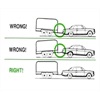Weight
Before setting off into the sunset with a caravan fully packed, it’s a good idea to
check out both the all-up weight and the ball weight of the loaded van. That can easily be done by driving the van to a weigh
bridge and without unhitching, take a weight measurement with just the van wheels on the weigh
bridge. That will give you the weight on the axles. A second measurement should be taken with the van unhitched and both the van wheels and the jockey wheel on the weighbridge. This will give you the all up weight. By subtracting the axle weight from the all up weight, you will get the weight on the jockey wheel (ball weight). This, to give a good handling combination, should be about 10 per cent of the all up weight. If it is not, then it will be time to move some stored items either backwards or forwards in the van. If there is still a problem, then it’s time to seek some specialist advice.
Keeping Level
In addition to getting the weight ratios right, having the van level also adds to driving stability. This may require modification to the ball mount or towing hitch to get it and the caravan tow hitch nearly level – a more common problem with larger 4WD’s. However, especially with larger vans, having a weight distribution hitch is almost mandatory as
well. Don’t just assume that beefing up the rear
suspension of the tow vehicle will fix things because it won’t In effect a weight distribution hitch transfers weight from the tow vehicle rear wheels to the front wheels, thus making the entire rig much more stable. Again, if you have a problem with this, then seek specialist advice.
 | Everyone who intends to tow a caravan, or indeed any sort of trailer, needs to be aware that various tow vehicle and trailer combinations can behave in slightly different ways and certainly different from just driving the tow vehicle itself. See Tow Vehicle Setup. |